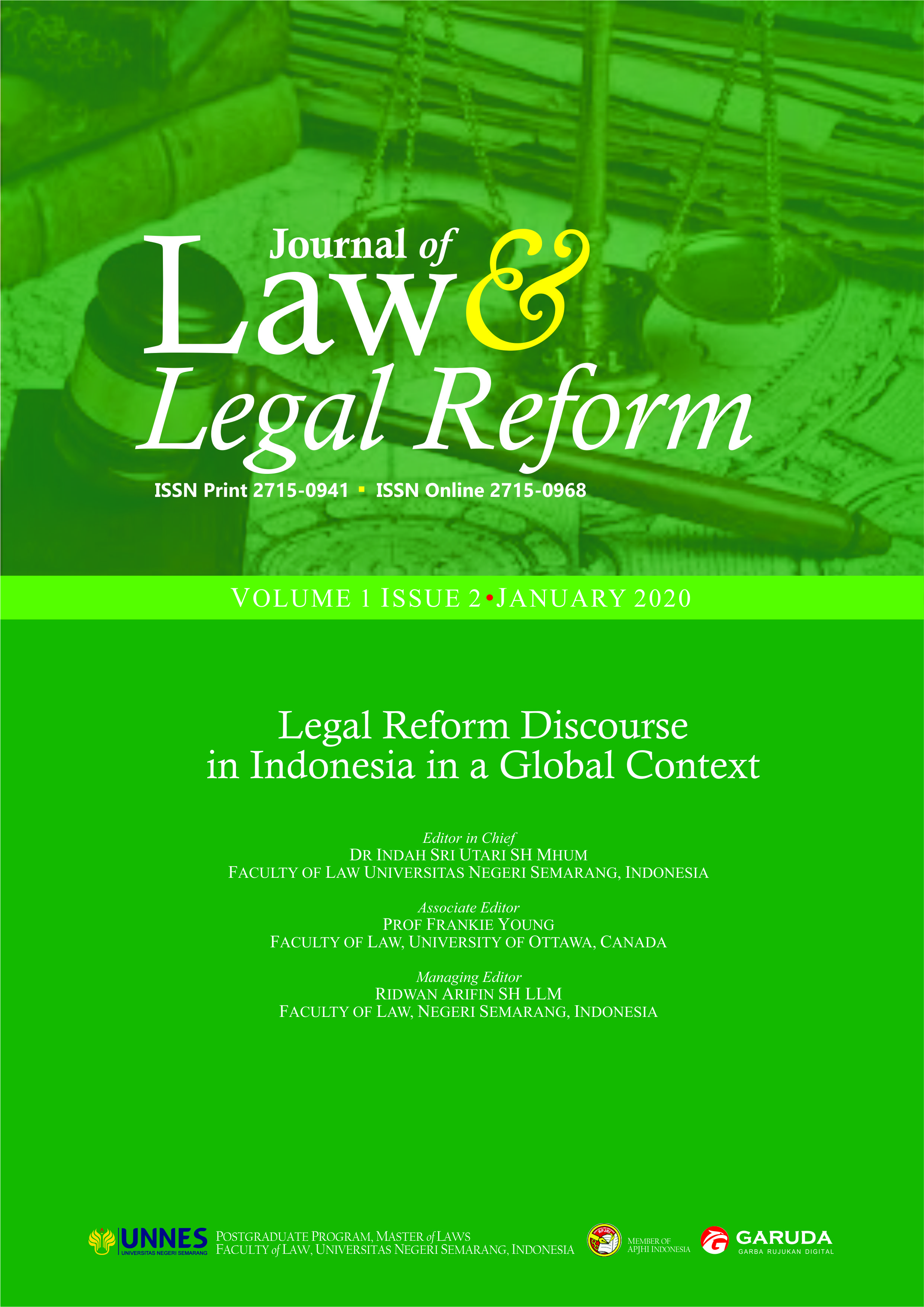Criminal Accountability for Corruption Actors in the Form of Concursus Realist
Main Article Content
Abstract
The purpose of this study is to describe and analyze the criminal liability arrangements for the perpetrators of corruption in the form of concurrent acts, finding juridical reasons to the extent to which corruption in the form of concurrent acts can be justified. This research method uses a qualitative approach with normative juridical law design. Data collection techniques using library research Subjects library research law faculty of Semarang State University. Data analysis techniques: (1) presentation, (2) data reduction, and (3) collection and verification. The results of the study: (1) the form of criminal liability from the perpetrators of corruption in the form of a joint act is to follow the criminal procedure in the Criminal Code by dropping the absorption system which is made worse by the regulation contained in the Constitutional Court's decision in the results of the criminal chamber meeting of the Supreme Court of the Republic of Indonesia Tangerang No 10 concerning the application of concursus teachings precisely in the parallel act of corruption. Conclusions of the study that the doctrine of concursus results of the criminal chamber meeting of the Supreme Court of the Republic of Indonesia Tangerang has a legal basis that serves as a guideline or legal basis so that the action does not go outside the lines of statutory provisions in the implementation of decision making in imposing penalties for the perpetrators of acts corruption in the form of a parallel act.
Article Details
All writings published in this journal are personal views of the authors and do not represent the views of this journal and the author's affiliated institutions. Author(s) retain copyrights under a Creative Commons Attribution-NonCommercial-ShareAlike 4.0 International (CC BY-NC-SA 4.0).
References
Fitarius, M.F. (2014). Analisis Yuridis Pertimbangan Putusan Hakim dalam Pemidanaan Terhadap Delik Tertinggal pada Kasus Concursus Realis. Jurnal Ilmu Hukum, 1-16. Retrieved from http://e-journal.uajy.ac.id/7160/1/JURNAL.pdf
Jonkers, J. (1987). Buku Pedoman Hukum Pidana Hindia Belanda. Jakarta: Bina Aksara.
Marpaung, L. (1999). Tindak Pidana Terhadap Nyawa dan Tubuh. Jakarta: Sinar Grafika.
Medan, K. (2010). Pengantar Ilmu Hukum. Kupang: Fakultas Hukum, Universitas Nusa Cendana.
Muhamad, M. (2007). Hukum Acara Pidana Kontemporer. Bandung: PT. Citra Aditya Bakti.
Mulyadi, M. (2010). Seraut Wajah Putusan Hakim dalam Hukum Acara Pidana Indonesia. Bandung: PT. Citra Aditya Bakti.
Prakoso, P. (1988). Pemecahan Perkara Pidana (Splitsing). Yogyakarta: Liberty.
Republic of Indonesia (1945). The 1945 Constitution of the State of the Republic of Indonesia, Undang-Undang Dasar Negara Republik Indonesia Tahun 1945
Republic of Indonesia (1999). Law of the Republic of Indonesia Number 31 of 1999 as amended and supplemented by Law of the Republic of Indonesia Number 20 of 2001 concerning Eradication of Corruption, Undang-Undang Republik Indonesia Nomor 31 Tahun 1999 sebagaimana diubah dan ditambah dengan Undang-Undang Republik Indonesia Nomor 20 Tahun 2001 tentang Pemberantasan Tindak Pidana Korupsi
Republic of Indonesia (2009). Law Number 48 of 2009 concerning Judicial Power, Undang Undang Nomor 48 Tahun 2009 Tentang Kekuasaan Kehakiman
Republic of Indonesia (1981). Law Number 8 of 1981 concerning the Criminal Procedure Code (KUHAP), Undang Undang Nomor 8 Tahun 1981 Tentang Kitab Undang- Undang Hukum Acara Pidana (KUHAP)
Republic of Indonesia. Indonesian Penal Code, Kitab Undang-Undang Hukum Pidana (KUHP)
Saleh, S. (1983). Perbuatan dan Pertanggungjawaban Pidana. Jakarta: Aksara Bara.
Suharto, S. (1996). Hukum Pidana Materil Unsur-Unsur Obyektif Sebagai Dasar Dakwaan. Jakarta: Sinar Grafika.
Soesilo, R. (1991). Kitab Undang–Undang Hukum Pidana serta Komentar- Komentarnya. Bogor: Politeia.
Utrecht, E. (1994). Hukum Pidana II. Surabaya: Pustaka Tinta Mas.
Utrecht, E. (1958). Rangkaian Sari Kulia Hukum Pidana II. Bandung: PT. Penerbit Universitas.
Utrecht, E. (1962). Hukum Pidana II. Bandung: Penerbit Universitas.
Waloyu, W. (1991). Implementasi Kekuasaan Kehakiman Republik Indonesia. Jakarta: Sinar Grafika.
